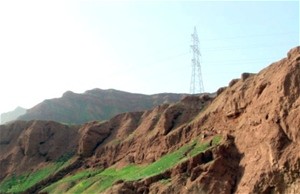
Soaring transmission towers dot the Salang Pass on their way to Kabul where they deliver imported power from bordering countries. Almost two trillion kilowatt hours are imported into Afghanistan annually.
AIRP/USAID
A USAID program enables importing power from three countries that border Afghanistan.
11 OCTOBER 2010 | KABUL, AFGHANISTAN
Like sentries, they stand, each 40 meters tall. A line of 1,389 of them stretches between Uzbekistan and central Kabul.
These soaring transmission towers string together 419 kilometers of double circuit wires. Since February 2009, they have delivered 24-hour electricity to Kabul and neighboring areas. Thousands of similar towers can be seen along the borders of Tajikistan and Kunduz and from Turkmenistan to the cities of Andkoy and Hirat.
The towers annually deliver almost two trillion kilowatt hours to the North East Power System and parts of the South East Power System. Costs are as low as two cents per kilowatt hour. USAID oversees the power import agreement that makes this possible and provides consulting services via the Afghanistan Infrastructure Rehabilitation Program.
The reality is that Afghanistan’s need for power presently outstrips its ability to generate it, while Uzbekistan, Tajikistan, and Turkmenistan have excess power that can be sold at negotiated rates over contracted periods of time. The contract with Tajikistan will last for 20 years; with Turkmenistan, for ten. The Uzbek contract is reviewed annually.
There have been challenges. Afghanistan’s mountainous terrain, sometimes at heights of 3,800 meters, or 12,500 feet, makes damaged or downed lines difficult to repair. Other actions posed by insurgent activity must also be surmounted. Yet imported power makes it possible for Kabul and other cities to receive a reliable supply of electricity.
The existence of these important agreements and the engineering and construction feats they have made possible, show that Afghanistan can build not just a necessary power grid, but also lasting and mutually beneficial relationships with its neighbors. USAID’s support has made these agreements possible, leading to the creation of a reliable energy sector that will serve the needs of Afghanistan and the region for years to come.







Comment
Make a general inquiry or suggest an improvement.